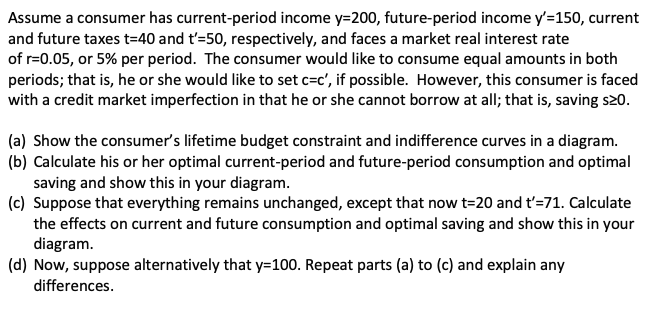Assume a consumer has current-period income y=200, future-period income y'=150, current and future taxes t=40 and t'=50, respectively, and faces a market real interest rate of r=0.05, or 5% per period. The consumer would like to consume equal amounts in both periods; that is, he or she would like to set c=c', if possible. However, this consumer is faced with a credit market imperfection in that he or she cannot borrow at all; that is, saving s20. (a) Show the consumer's lifetime budget constraint and indifference curves in a diagram. (b) Calculate his or her optimal current-period and future-period consumption and optimal saving and show this in your diagram. (c) Suppose that everything remains unchanged, except that now t=20 and t'=71. Calculate the effects on current and future consumption and optimal saving and show this in your diagram. (d) Now, suppose alternatively that y=100. Repeat parts (a) to (c) and explain any differences.
Assume a consumer has current-period income y=200, future-period income y'=150, current and future taxes t=40 and t'=50, respectively, and faces a market real interest rate of r=0.05, or 5% per period. The consumer would like to consume equal amounts in both periods; that is, he or she would like to set c=c', if possible. However, this consumer is faced with a credit market imperfection in that he or she cannot borrow at all; that is, saving s20. (a) Show the consumer's lifetime budget constraint and indifference curves in a diagram. (b) Calculate his or her optimal current-period and future-period consumption and optimal saving and show this in your diagram. (c) Suppose that everything remains unchanged, except that now t=20 and t'=71. Calculate the effects on current and future consumption and optimal saving and show this in your diagram. (d) Now, suppose alternatively that y=100. Repeat parts (a) to (c) and explain any differences.
Chapter17: Capital And Time
Section: Chapter Questions
Problem 17.7P
Related questions
Question

Transcribed Image Text:Assume a consumer has current-period income y=200, future-period income y'=150, current
and future taxes t=40 and t'=50, respectively, and faces a market real interest rate
of r=0.05, or 5% per period. The consumer would like to consume equal amounts in both
periods; that is, he or she would like to set c=c', if possible. However, this consumer is faced
with a credit market imperfection in that he or she cannot borrow at all; that is, saving s20.
(a) Show the consumer's lifetime budget constraint and indifference curves in a diagram.
(b) Calculate his or her optimal current-period and future-period consumption and optimal
saving and show this in your diagram.
(c) Suppose that everything remains unchanged, except that now t=20 and t'=71. Calculate
the effects on current and future consumption and optimal saving and show this in your
diagram.
(d) Now, suppose alternatively that y=100. Repeat parts (a) to (c) and explain any
differences.
Expert Solution
This question has been solved!
Explore an expertly crafted, step-by-step solution for a thorough understanding of key concepts.
This is a popular solution!
Trending now
This is a popular solution!
Step by step
Solved in 2 steps with 3 images

Knowledge Booster
Learn more about
Need a deep-dive on the concept behind this application? Look no further. Learn more about this topic, economics and related others by exploring similar questions and additional content below.Recommended textbooks for you


Exploring Economics
Economics
ISBN:
9781544336329
Author:
Robert L. Sexton
Publisher:
SAGE Publications, Inc


Exploring Economics
Economics
ISBN:
9781544336329
Author:
Robert L. Sexton
Publisher:
SAGE Publications, Inc